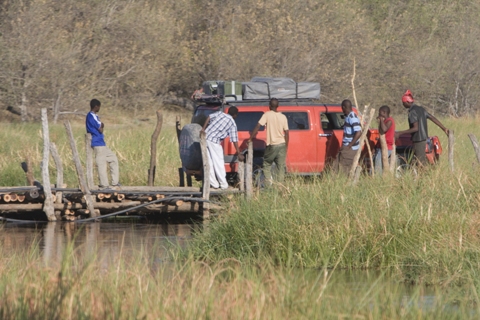
In part 1 of our interview with adventure photographer Chris Collard, we learned the background on his African HUMMER adventure and rig — now on to the journey!
How was the H3 perceived by the locals along the route?
It is definitely hard to blend in when you’re driving a bright red HUMMER. It didn’t matter where I was, remote two-tracks of the bush, small villages, or major city, people knew what the HUMMER was and I’d hear the call HUUUMMAAAA, HUUUMMAAAA everywhere I went. It was instant celebrity. At least a thousand people took pictures of it with their cell phones, usually with them in front of it. In many cases, I’d have them sit behind the wheel and get the feel for it. Always with HUGE smiles and wide eyes. Other overlanders, especially the Land Rover and Land Cruiser folks, queried “How does it do in the bush and sand Mate,” and were excited to see that my H3 had a month’s worth of dirt, dust and mud caked on it and was actually being used.
What was considered ‘normal’ driving terrain, and how did the H3 do?
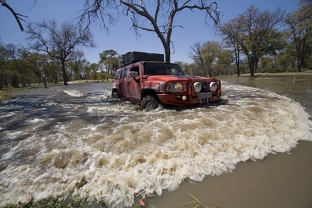 Normal? There’s nothing normal about Africa. It is constantly morphing from one dynamic to another. Morphing from one state of disarray to the next, with short breaks of calm. And there are three simple letters to describe it, “TIA.” It’s an acronym for “This Is Africa”, and it’s applicable to any time things are FUBAR, which can be quite often.
Normal? There’s nothing normal about Africa. It is constantly morphing from one dynamic to another. Morphing from one state of disarray to the next, with short breaks of calm. And there are three simple letters to describe it, “TIA.” It’s an acronym for “This Is Africa”, and it’s applicable to any time things are FUBAR, which can be quite often.
Normal….. I digress.
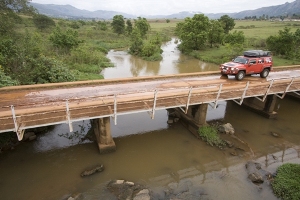 Not enough people actually know the true potential of the H3. I rolled about 12,000 kilometers on the odometer during the fifty days on the road, about 7,000 on the dirt. The high elevation routes of Lesotho were mere goat tracks: steep rocky ascents, descents, and deep ruts. The Kalahari is famous for deep sand, and it held up to its reputation. One day between the Khutse Reserve and the Central Kalahari we logged in 200+ kilometers over deep sand tracks. The combination of the HUMMER’s flexible suspension, the drivetrain’s power curve and ample torque, and the Yokohama Geolander tires (at 15psi) made short work of this formidable foe.
Not enough people actually know the true potential of the H3. I rolled about 12,000 kilometers on the odometer during the fifty days on the road, about 7,000 on the dirt. The high elevation routes of Lesotho were mere goat tracks: steep rocky ascents, descents, and deep ruts. The Kalahari is famous for deep sand, and it held up to its reputation. One day between the Khutse Reserve and the Central Kalahari we logged in 200+ kilometers over deep sand tracks. The combination of the HUMMER’s flexible suspension, the drivetrain’s power curve and ample torque, and the Yokohama Geolander tires (at 15psi) made short work of this formidable foe.
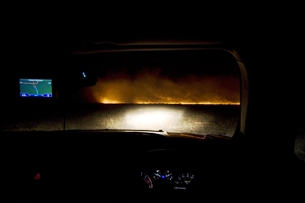 Late one night during the raging Kalahari fires (which swept though 90,000 sq km), I ran into a park ranger vehicle that was bogged in the sand on an uphill incline. I pulled around to the high side, hooked up a strap (as the rangers shook their heads with doubt) and pulled them to the top of the hill. I pulled several other rigs out during the trek, including a 7.5-ton dump truck that was stuck in a sandy riverbed in Swaziland. Only one of the men spoke English (broken English at best) and I could see they had major doubts about the H3 doing the job. They’d been there since the day prior and I was the only option they had. It took a little digging around the tires, but when the dust settled, they were all smiles and the one man kept lamenting, “This is a different car! This is a different car….”
Late one night during the raging Kalahari fires (which swept though 90,000 sq km), I ran into a park ranger vehicle that was bogged in the sand on an uphill incline. I pulled around to the high side, hooked up a strap (as the rangers shook their heads with doubt) and pulled them to the top of the hill. I pulled several other rigs out during the trek, including a 7.5-ton dump truck that was stuck in a sandy riverbed in Swaziland. Only one of the men spoke English (broken English at best) and I could see they had major doubts about the H3 doing the job. They’d been there since the day prior and I was the only option they had. It took a little digging around the tires, but when the dust settled, they were all smiles and the one man kept lamenting, “This is a different car! This is a different car….”
Was there anything that surprised you about the H3?
How comfortable it is and how well it tracked through deep sand and over the low-range stuff. My only gripe was that at 25 kilometers per hour, the doors automatically lock (and the seatbelt buzzer goes off at 25km and 50km if the belt is not latched), and stay locked until you turn the key off. Don’t know how many times I yanked on the door latch with the engine still running, and it was still locked.
Chris’s truck may have had a strange right-hand drive issue, since H3s in the US are set to lock and unlock when taken out of and into Park.
More to come on Chris’s African HUMMER Adventure!
 Hummer Guy Hummer News and Opinion from an experienced off-road instructor
Hummer Guy Hummer News and Opinion from an experienced off-road instructor
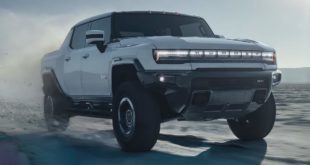
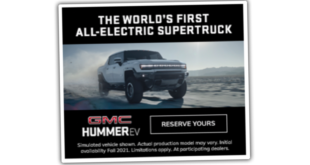
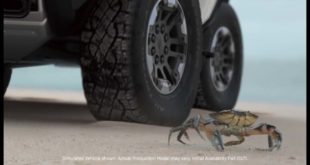
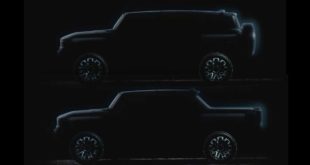
The doors locking at 25km is correct for any Manual transmission GM vehicle, because the lack of “park”. However it can be disabled.